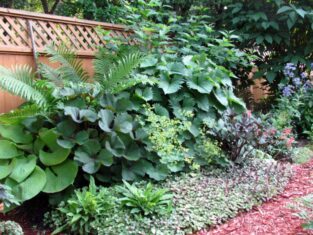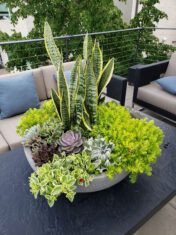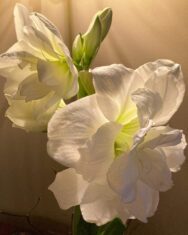
Finally, at the middle of February, the days begin to grow noticeably longer and we begin to anticipate spring. Of course, there are still several weeks of winter in front of us with the potential for more snow and ice. But I prefer to be proactive about spring activities and get started early by forcing some flowering branches.
Most spring-flowering shrubs can be forced into bloom indoors by easing them out of dormancy over a period of one to three weeks. I begin in mid-February with Cornelian cherry (Cornus mas), witch-hazel (Hamamelis x intermedia), redbud (Cercis canadensis) and forsythia. I cut a second batch of branches at the beginning of March from mock orange (Philadelphus spp. and cvs.), shrub honeysuckle (Lonicera spp. and cvs.) and February daphne (D. mezereum). The younger branches of woody plants usually carry the most flower buds, which appear more round and puffy than the slimmer leaf buds. If you’re unsure, use a razor blade to cut a bud open and look for recognizable flower parts inside.
With a sharp knife or secateurs, cut a cross into the bottom inch of each stem to encourage water uptake. Put the cut branches into a basement utility sink or bath tub overnight, submerging them completely, if possible, in cold water for 12 hours; then stand them in a bucket or vase containing water, and set them in a cool, bright location, away from direct sunlight. (Too much heat or sunlight can cause the buds to drop.) Change the water every other day to keep it fresh and prevent bacteria from entering the stems. A floral preservative in the water will help to prolong the display.
Soon the buds will begin to swell and crack open, and then the branches can be arranged in vases wherever you want a display of flowering branches. Moving the arrangements to a cool place at night will help the flowers last longer. I’ve noticed a difference in petal colour as the result of maturing indoors, away from ultraviolet light. For instance, deeply coloured flowers like red Japanese quince (Chaenomeles spp. and cvs.) may fade to pink, although they’re still lovely.
All kinds of branches can be forced. If you have access to fruit trees, try apple, apricot, pear and peach branches. Smaller spring-blooming shrubs like azalea, cotoneaster and deutzia are pretty in mixed arrangements. Foliage branches are also beautiful to have indoors, and you can try any kind of beech, Japanese maple, willow and dogwood. Be careful where you cut and don’t take too much. It requires only a few branches to make a beautiful vase display that will gives weeks of pleasure while real spring is developing outside.









To Suzin, Feb. 24
Isn't that terrific, they remember the location of your garden, and exactly where the food source should be! I stir the sugar into the water, cover the pot, and bring the liquid to a rapid boil (no need to boil any longer after that). Then remove from the heat and allow to cool down to room temperature before putting it into the feeder. Yes, the change of seasons is coming up, and I've seen some indications that spring might be early this year. However, I'm not going out on a limb about it just yet. But we live in hope!
Hi Judith … I've been feeding my "sweeties" for years on the store bought Hummingbird nectar (I know shame on me) and have never made nectar myself, so do I add the sugar when the water is boiling or when I take it off the heat? I try to get my feeder out around the middle of May but most times they tell me when I first see them hovering around the spot where the feeder should be! 25 days till Spring…Yippeeeeee!
To genepher, Feb. 20
I'm glad we share this interest! Please let me know if your feeders have visitors this summer. Each August I spend some time in Algonquin Park, at an inn with a long wrap-around porch. Hummingbird feeders are hung approximately every 10 feet, and a small crowd of hummers is constantly flitting from one to the other. They're quite competitive, and the action is swift and sometimes ferocious. I'm sure my little hummer is there!
As a 'founding' subscriber to Garden Making mag and recent newcomer to the web I am delighted with your blog and the excellent website of the magazine. Lots of advice re hummingbirds- which visit my 40 yr. old 'Cambridge' monarda. I am now encouraged to put up feeders for these tiny jewel birds. Thanks.